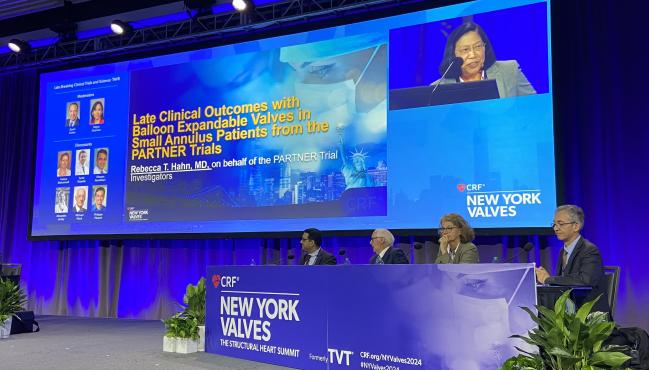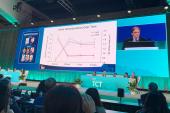Reassuring 5-Year Outcomes for Sapien-Treated TAVI Patients With Small Annuli
Early hemodynamics with the balloon-expandable device do not adversely affect outcomes at 5 years in patients with small annuli.

NEW YORK, NY—Five years after undergoing TAVI with a balloon-expandable valve, patients with small annuli have similar risks of all-cause mortality and disabling stroke as patients with large annuli, according to an analysis from the PARTNER investigators.
In patients with a CT-derived systolic aortic annular area ≤ 430 mm2, neither higher mean gradients nor prothesis-patient mismatch (PPM) after TAVI were associated with clinical events at 5 years. Additionally, investigators observed no heightened risk for aortic valve reintervention or bioprosthetic valve failure (BVF) in those with small annuli undergoing TAVI with the balloon-expandable bioprosthesis (Sapien 3; Edwards Lifesciences).
The results provide reassurance that despite patients with small annuli having higher aortic mean gradients and PPM, “there is no impact on clinical outcomes or valve durability out to 5 years,” said lead investigator Rebecca Hahn, MD (NewYork-Presbyterian/Columbia University Irving Medical Center, New York, NY).
Hahn presented the analysis here at New York Valves 2024, previously known as the TVT meeting.
Earlier this year at the American College of Cardiology Scientific Sessions, the SMART investigators presented provocative data hinting that a self-expandable valve (Evolut PRO/PRO+/FX; Medtronic) would be preferable to a balloon-expandable device in a patient with a small native annulus. In that head-to-head randomized trial, patients treated with the balloon-expandable valve had higher mean gradients, higher PPM, and higher overall rates of hemodynamic structural valve dysfunction at 1 year when compared with the self-expanding valve.
“There is the suspicion that there'll be a difference in [clinical] outcomes associated with the difference in gradients and prothesis-patient mismatch that we’re seeing with the two valves,” Hahn told TCTMD. “But the SMART trial only has 1-year follow-up at this point. We’ll have to wait to get the 5-year follow up. We have 5-year follow-up with the balloon-expandable valve, and it clearly shows that the balloon-expandable valve used in the PARTNER trials does not have a signal for mortality based on [mean aortic] gradient or PPM.”
Dharam Kumbhani, MD (UT Southwestern Medical Center, Dallas, TX), the discussant following Hahn’s presentation, noted that in these PARTNER data, as in SMART, the rate of moderate-to-severe PPM with the balloon-expandable valve was approximately 45%; however, the percentage of patients with mean gradients ≥ 20 mm Hg was lower in the PARTNER analysis.
“The SMART 5-year data will be very important because at least [in the PARTNER analysis], it looks like the 5-year outcomes are not contingent on hemodynamics,” he said.
David Cohen, MD (St. Francis Hospital, Rosyln, NY), who moderated the late-breaking clinical trial session, said the accumulating data pose a conundrum to the practicing physician.
“We have lots of people using balloon-expandable valves in small annuli and then you have the SMART trial come out and show high gradients in those with small annuli [treated with] the balloon-expandable valve,” he told TCTMD. “No differences in clinical outcomes, but people are struggling with how to interpret the results.”
Low Rates of Reintervention and BVF
The new study included 1,355 symptomatic patients with aortic stenosis included in the PARTNER 2/S3i registry and PARTNER 3 randomized, controlled trial. Of these, 476 (35%) had a small annulus.
Those with a small annulus were slightly older than those with a large annulus (79.6 vs 78.7 years), were more likely to be female, had a higher STS score, and had a higher left ventricular ejection fraction. They were also less likely to have atrial fibrillation and coronary artery disease. Mean gradients were higher in those with a small annulus (14.0 vs 11.0 mm Hg), as was the stroke volume index. The rate of severe PPM was 11.1% in those with a small annulus versus 4.1% in patients with a large annulus.
At 5 years, the rate of death/disabling stroke was 36.3% and 35.8% in those with a small and large annulus, a nonsignificant difference. All-cause mortality was also no different (28.5% vs 29.3%, respectively; P = 0.56).
The need for aortic valve reintervention was 2.7% in those with a small annulus and 1.8% in those with a large annulus, also a nonsignificant difference. BVF, defined using VARC-3 criteria, occurred in 2.9% and 2.1% of those with small and large annuli, respectively (P = 0.46).
In an analysis of small-annuli patients stratified by mean gradients, there was no difference in clinical outcomes (all-cause mortality/disabling stroke or all-cause mortality alone) between those with gradients < 20 mm Hg and those with gradients ≥ 20 mm Hg. The need for reintervention and BVF also did not differ based on mean gradients. Finally, there was no significant difference in all-cause mortality/disabling stroke at 5 years in those with no PPM, moderate PPM, and severe PPM (30.4%, 35.5%, 44.1%, respectively; P = 0.22).
Cohen said the new data help provide some clinical direction, particularly the analysis looking at the outcomes of patients with mean gradients ≥ 20 mm Hg.
“They didn’t have that many patients with high gradients so it was a bit underpowered, but it certainly seemed reassuring,” said Cohen. “You contrast that with the data from the CoreValve trials where Medtronic has shown for several years that the gradients make a big difference, that they predict mortality, heart failure hospitalizations, and valve failure. We have one dataset with one valve that says [mean gradients] don’t matter and another that says it does.”
The only way to resolve the issue, he added, is to wait for the long-term follow-up from the SMART trial.
Different Devices, Different Hemodynamics
To TCTMD, Hahn emphasized that the “echocardiographic footprint” of the balloon-expandable valve differs from the self-expanding valve.
“We've shown in a number of different studies that because of the construct of the valves, one a short frame and the other a tall frame, we have very, very different echocardiographic and invasive hemodynamics that have been measured,” she said. “We know that the short-framed balloon-expandable valve will have flow acceleration before the leaflets and pressure recovery after the valves within in the aorta.”
The balloon-expandable valve has a significantly higher echocardiographic gradient than the self-expandable valve, but it has a lower invasive gradient, said Hahn. Given the construction of the valves, they can’t be treated the same, nor should the hemodynamics be compared.
“The hemodynamics of one valve are not necessarily reflective of the hemodynamics and outcomes of another valve,” she said.
Cohen added that the data to date do suggest that relationship between mean gradients and clinical outcomes differ between the valves.
Kumbhani said that when faced with a patient with a small annulus, physicians need to account for multiple factors, not just hemodynamics, when making a decision about the best valve to implant. If operators are selecting the self-expanding valve because of its better hemodynamic profile, they need to make sure there’s enough room for a second valve should it be needed.
“I’ve been implanting valves for 15 years and some of the patients with CoreValve are coming back and we’re doing a valve-in-valve procedure, or a TAVI explant, which is a really, really big endeavor,” he told TCTMD. “A small annulus usually comes with a small [aortic] root. For patients with CoreValve, there is no sinus left. If you put another CoreValve in there, you’re going to obliterate the coronaries.”
Michael O’Riordan is the Managing Editor for TCTMD. He completed his undergraduate degrees at Queen’s University in Kingston, ON, and…
Read Full BioSources
Hahn RT, on behalf of the PARTNER trial investigators. Late clinical outcomes with balloon-expandable valves in small annulus patients from the PARTNER trials. Presented at: New York Valves 2024. June 5, 2024. New York, NY.
Disclosures
- Hahn reports speaking honoraria from Abbott Structural, Baylis Medical Edwards Lifesciences, Medtronic, Philips Healthcare, and Siemens Healthineers. She reports institutional research contracts from Abbott Structural, Anteris, Edwards Lifesciences, Medtronic, and Novartis.
- Cohen reports grant support/research contracts from Boston Scientific Corporation, Edwards Lifesciences, Corvia, Ancora Heart, Abbott, Philips, Medtronic, and CathWorks. He reports consulting fees/honoraria from Medtronic, Boston Scientific, Elixir Medical, Edwards Lifesciences, and Abbott.
- Kumbhani reports no relevant conflicts of interest.





Wacin Buddhari
Wacin Buddhari